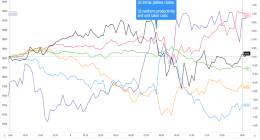
OK. what happens next? Last week the Bank of England shocked the financial markets, and many homebuyers, by raising rates by half a per cent instead of a quarter.
Instead of doing the minimum the markets had expected, it did a bit more. At last the majority of the Monetary Policy Committee is coming to terms with its failure to raise rates fast enough, even if two external members – both professors at the London School of Economics – voted for no change. There’s a bit of a gap between some academics and the real world.
Rates will probably go higher still. The yield on one-year gilts is around 5.25 per cent and two-year yield just over 5 per cent. That pushes up the cost of borrowing for everybody. If it costs the Government more than 5 per cent to borrow for two years, it will cost a mortgage payer around 6 per cent. Even the most creditworthy homebuyer has to pay a bit more than His Majesty’s Government.
The challenge now is to stop higher rates from tanking the economy. Actually it is not doing too badly, given everything that has been thrown at it. Retail sales were up a bit in May and the forward-looking purchasing managers’ index is signalling continuing slow growth.
Some people will still have a cash cushion built up over the pandemic when they could not spend their income, and cash is at last starting to earn a bit of interest. But many families will have to cut back and there is rightly huge pressure on mortgage lenders to stop people being thrown out of their homes.


What happens next?: Rates will probably go higher still, but we may expect the first cut in the first half of next year
Let’s hope the agreement on Friday between Chancellor Jeremy Hunt and the lenders proves effective. Let’s also remember that most people who bought two or more years ago will have a profit in their homes, albeit only a paper one, until they sell. Over the 25-year period of a mortgage there will be a valuable asset at the end.
Keeping a reasonable level of confidence in the housing market is really important, because what happens there is an important determinant of consumer confidence. Private consumption is around 65 per cent of GDP and we are going to need confident consumers to pull us through to the time when rates can start to fall.
My guess is that we are about halfway through the downturn from the peak last September and the market will start to recover early next year. But much depends on the timing of that first cut in rates. Once people can look through the soaring cost of mortgages, then confidence can start to return. The underlying demand for somewhere to live is as strong as ever.
And that first cut in interest rates? Of course that depends on the pace at which inflation declines. There was a chink of light in those numbers last week. Everyone understandably focused on the fact that at a consumer level inflation is stuck. But at a wholesale level it has come whizzing down.
The producer price index – what companies charge for what they sell – was up nearly 20 per cent last July. That was terrifying, and it speaks well of our distribution system that at a consumer level inflation was not much more than half that. Now the index has fallen to only 2.9 per cent year-on-year and on a six-month basis is negative. It will take a few months more before falling producer prices feed right though to the prices we pay in the shops.
I’m also worried about rising costs in the service industries, where staff shortages are making life really tough. But we are past the peak and the uncertainties are about the speed at which inflation declines and where it settles, not whether it will go on falling.
If this is more or less right, we can expect the first cut in interest rates in the first half of next year – probably in February, because that is when the Bank updates its forecasts in the quarterly Monetary Policy Report. However that does not mean that the ultra-low rates of the past decade will come back, certainly not for a generation. Maybe never.
Never? Well, that is rather a long time, but note this. Until the end of 2011 at no stage during the previous 300 years had the yield on 10-year gilts ever been below 2 per cent. But it dipped below that for most of the next decade, bottoming at 0.074 per cent in August 2020. That pulled down the cost of borrowing for everyone. Now it is back to 4.3 per cent.
So what borrowers experienced for that decade was quite unprecedented. Rates will come down a bit, but not to the levels that many homebuyers think of as normal.









